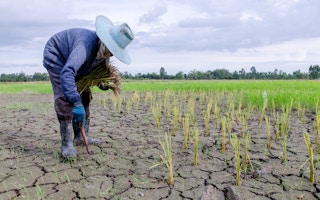Before the driverless car, we had the driverless tractor. Yet since then, investment and innovation in sustainable transportation has captured the public’s imagination, leaving agriculture in its tracks.
To continue reading, subscribe to Eco‑Business.
There's something for everyone. We offer a range of subscription plans.
- Access our stories and receive our Insights Weekly newsletter with the free EB Member plan.
- Unlock unlimited access to our content and archive with EB Circle.
- Publish your content with EB Premium.
By developing a model that can be powered by renewable energy, Tesla has reimagined the car market and harnessed the advantages of a simple sustainable solution: in batteries, motors and powertrain.
Similar opportunities exist in agriculture. Even the Tesla mogul’s brother Kimbal Musk has recently been championing a reform of North America’s food systems to make wholesome food affordable. But the potential to transform agriculture offers even broader rewards globally to benefit both people and planet.
In start-up terms, there are many minimum viable products at the ready to revolutionise farming worldwide. What is missing are the innovative collaborations between researchers, entrepreneurs and policymakers to scale them up to a make a difference at the same pace and scale of the electric vehicle.
Why does this matter? Like the transport sector, agriculture plays a significant role in climate change, with food systems contributing up to 29 per cent of global greenhouse gas emissions.
And as with the transport sector, the demands on global agriculture are increasing exponentially. With a billion more people to feed by 2030, we will need 13 per cent more food per hectare.
In the meantime, we are facing an increasing number of extreme weather events as the fight continues to limit global warming to less than 2C.
This year alone, almost every continent has suffered from climate-related disasters from droughts across the Horn of Africa to flooding in South Asia. All of these have had an impact on our global food supplies.
But as devastated countries rebuild and others brace themselves for more unpredictable conditions, creating a more sustainable agricultural sector offers the best hope of coping with the impact of climate change.
And climate action through agricultural transformation comes with a whole host of globally beneficial advantages.
For instance, adapting agriculture to climate change through early-maturing and drought-resilient crops helps us to preserve land and water resources without compromising on yield. This will be crucial when it comes to producing more food for a bigger population with finite reserves.
New fertilizer techniques that slow down the conversion of ammonia to nitrogen when applied to crops can also help lower emissions while also improving productivity and sparing the conversion of virgin land to agriculture.
Innovations such as solar-powered groundwater pumps have also shown promise for improved water conservation, increased crop production and renewable energy generation. Investing in scaling up technologies like this offers an exciting opportunity for transforming agriculture.
“
The key is to unlock Silicon Valley-style ambition and thinking in agriculture.
Gender equality is another key benefit of climate action in agriculture, as female smallholders and heads of households are often unduly affected by climate change.
For example, the Adaptation for Smallholder Agriculture Programme (ASAP), led by the International Fund for Agricultural Development (IFAD), is investing more than $300 million to increase the resilience of at least eight million smallholders in more than 30 countries.
In Nigeria, this means working to diversify women’s livelihoods as a way of increasing their resilience to climate shocks, which can often leave families devastated when they depend on single or vulnerable crops.
And potentially the most exciting for would-be agri-entrepreneurs is the strong business case for climate action in agriculture.
One emerging instrument to help adapt to climate change is index-based insurance, which protects smallholders’ incomes in the face of climate-related losses based on a weather-related index. With two billion smallholders bearing the brunt of billions of dollars of climate-related disasters, it remains an untapped market inviting investors to find ways to scale it up.
Technological innovations, such as satellite imagery, which can make insurance products more precise, cost-effective and viable already exist. We have seen some multinationals help expand this to great effect – but more can be done to fully open up this market.
Harnessing the opportunities offered by agriculture can help us to meaningfully take action on the climate while also offering security against famine, disease and poverty.
The key is to unlock Silicon Valley-style ambition and thinking in agriculture. By bringing together public and private organizations at this year’s COP, we hope to make a start in unlocking the opportunities within agriculture. But we need both bold public sector initiatives and private sector investments to be able to scale up these possibilities and make it everyone’s advantage.
After all, a country cannot transition to electric cars or build green infrastructure or fulfil the Paris Agreement on an empty stomach. At this year’s COP, let’s inspire the Tesla’s of tomorrow around the world to take on climate action in agriculture.
Bruce Campbell is director of the CGIAR Research Program on Climate Change, Agriculture and Food Security. This article is republished from the Thomson Reuters Foundation.











